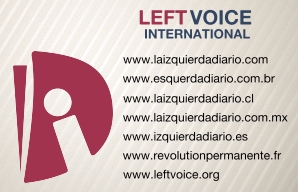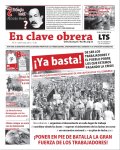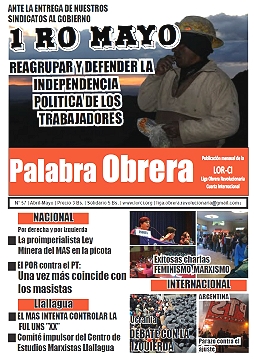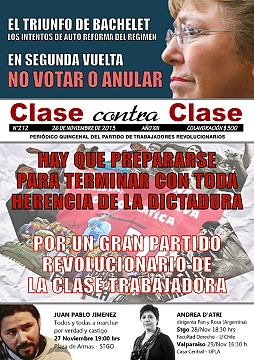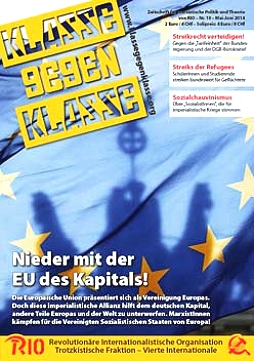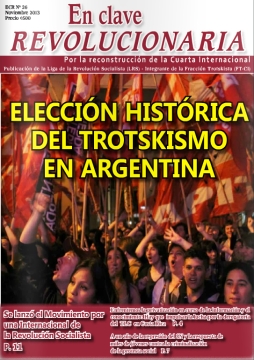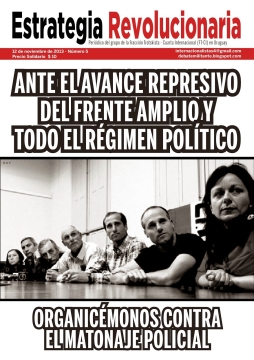After the presidential elections
Iran: Rebellion and political crisis
25/06/2009
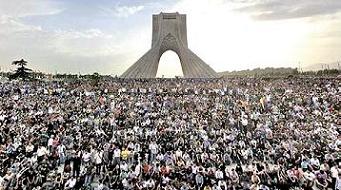
Since current President Mahmoud Ahmadinejad was awarded a spectacular victory in the June 12 presidential elections, with 63% of the votes against 34% for his rival, the "reformist" Mousavi, the streets of Tehran and the main cities of the country have been changed into the stage for massive mobilizations, police and para-police repression, confrontations, attacks on university campuses, arrests and death.
Hundreds of thousands of youth — in their great majority, university students — professionals and groups from the prosperous urban middle classes, followers of the defeated Mousavi, mobilized to repudiate what is now considered a fraud and to demand that new elections be carried out. The followers of President Ahmadinejad also mobilized massively to support the disputed election victory.
Although it is true that the charges have not been proven and that several analysts from different Western media had foreseen the possibility of a victory by Ahmadinejad, based especially on the high level of voting and on the fact that popular groups could have voted for him as the "lesser evil," the scope of the victory, that practically duplicated the results that he got in the 2005 elections, is, whichever way you look at it, contradictory to the perception that his government has given rise to a broad political and social opposition.
Together with divisions in the leadership of the regime, another element that acted as a detonator of the crisis is the deep dissatisfaction of big sectors of society, particularly the urban middle classes, with President Ahmadinejad and the theocratic regime, that maintains a rigid discipline based on religious surveillance and social and ideological control, expressed in the oppression of women, brutal punishment of homosexuals and the denial of the democratic rights to political and social organization.
Bearing in mind the enormous polarization that preceded the elections and the growth of the mobilizations in favor of Mousavi, that some have named the "green wave," because of the color that identifies his supporters, Ahmadinejad’s aim in announcing his election victory with a devastating lead was probably to avoid a possible runoff election in which the incumbent could be defeated by Mousavi.
In a kick-off, the supreme leader of the Islamic Republic of Iran, Ayatollah Ali Khamenei, endorsed Ahmadinejad’s victory, but as the mobilizations were growing, and with the perspective that they could get out of control, he agreed to Mousavi’s request and ordered a partial recount of the votes. However, that political gesture was not sufficient to put an end to the mobilizations, that still persist in spite of state repression and the fact that the opposition leader Mousavi has called on his followers to remain in their houses to "avoid violence."
Many compare this process to the so-called "Color Revolutions," in which imperialism, especially US imperialism, supports and finances "democratic" movements to bring its allies to power — as was the case with the "Orange Revolution" in Ukraine, or the "Cedar Revolution" in Lebanon. Actually, together with military hostilities, one of the options for "regime change," that US imperialism was manipulating under Bush was promoting a kind of "Velvet Revolution" (imitating the 1989 mobilizations against the Stalinist regimes), that, combined with the pressure of economic sanctions and isolation, would lead to the fall of the theocratic regime, but this policy failed to give the expected results, and, despite the fact that Iran is surrounded by counties occupied by imperialist troops, the overthrow of Saddam Hussein strengthened Iran’s position as a regional power. With Obama’s arrival in office, imperialism changed tactics. In spite of the pressure and criticism from the Republicans, up to now, Obama has been avoiding declaring himself openly in favor of the candidate Mousavi and his charges of fraud, by insisting that he "respects Iranian sovereignty." In this way, he is trying to avoid giving the Iranian regime an "anti-imperialist" argument, and, at the same time, encouraging the phantasm of "regime change," stirred up by Bush and the neo-conservatives. Hostilities are dysfunctional for his current strategy, which is trying, through diplomatic means, to "persuade" the Iranian regime to abandon its nuclear intentions and commit to maintaining stability in Iraq and Afghanistan through greater collaboration.
It is still not clear how the conflict will be resolved, and whether, as in previous cases, the regime will be able to stifle the mobilizations with repression and wearing them down, or whether it will find itself forced to make more concessions. But this political crisis, beyond how it might end, could be a turning point in post-revolutinary Iran and give rise to a new situation, characterized by the intervention of the masses on the political stage, a visible split in the governing elite and a big erosion of the legitimacy of the theocratic regime.
Splits in the regime
The challenge to the elections and, in the final instance, to the regime, constitutes the worst political crisis since the 1999 students’ uprising, under the government of the "reformist" Khatami, that ended with brutal repression. The dispute over the results lays bare the struggles for power in the leadership of the theocratic regime and the differences over decisions that are considered strategic, primarily, how to face relations with the United States and the countries of the Middle East. This conflict has divided the governing elite into two factions: on the one hand, the so-called "conservative" block, composed of President Ahmadinejad, the Ayatollah Khamanei, a large part of the traditional institutions of the Iranian theocracy and the military and police corps and the so-called "volunteer militias" that patrol the streets of the cities to keep order and soical control. On the other hand is the so-called "reformist" bloc, formed by Mousavi, former President Khatami and the cleric Rafsanjani, Chairman of the Assembly of Experts, one of the organs of the Shiite clergy that has a lot of weight in state decisions and in the election of the supreme religious leader.
However, these frictions do not imply strategic differences. All the groups of the dominant Iranian elite support opening official negotiations with the United States, including the "conservative" Ahmadinejad and the high clergy hierarchy, that, in fact, collaborated with the US occupation of Iraq, from which it came out with ample benefits. But, while Ahmadinejad and his allies support maintaining a harder position in the negotiations, with "gestures" of some independence, like the missile tests and continuing the nuclear program, confronting the State of Israel or the alliance with Hezbollah and Hamas, Mousavi and the "reformist" block are in favor of making bigger concessions to ease tensions between Iran and the "West," thus allowing the lifting of economic sanctions that weigh on the country and allowing the entry of imperialist capital, aiming at an economic opening.
The two wings of the regime
Mahmoud Ahmadinejad, a former member of the Revolutionary Guards, tied to the repressive forces of the state apparatus, had won a popular base when he assumed the presidency in 2005, by denouncing the corruption of the dominant elite, that visibly enriched itself during the 30 years that it spent in power. During the first years of his government, as a result of the rise in oil prices, he gave subsidies to the urban and rural poor and rewards to state employees and indirectly favored the bazaar bourgeoisie, the hard nucleus of the social base of the Shiite theocracy. This policy was accompanied by reinforcing control by the state repressive forces and para-police militias like the basijis (volunteer militias). His "reformist" rivals, supporters of obtaining foreign capitalist investments, accused him of being a "populist" and needlessly exacerbating tensions with the United States.
But the Iranian economy has suffered the impact of the international capitalist crisis. According to the Iranian Central Bank, inflation climbed to 24% (although the government only admits 14%), and unemployment reached 17%. Prospects indicate another year of decline in economic growth, a result of the fall in oil prices, and the lack of investments and of an infrastructure adequate to exploit the country’s oil resources.
During the campaign, Ahmadinejad resumed his populist rhetoric: he even accused Rafsanjani and several members of the "old guard" of the 1979 revolution of enriching themselves by appropriating state resources for themselves. However, his policies are increasingly unpopular. Not only did he continue repressing workers’ strikes and imprisoning their leaders, but at the beginning of the year he also sent Parliament a budget in which food price subsidies that favor the poorest groups in the society, are cut.
This situation nurtured the discontent of broad groups towards the government and was perceived as an opportunity for the "reformist" wing of the regime to defeat Ahmadinejad in the presidential elections, which united key figures of the religious-political establishment behind a program centered on a more conciliatory policy towards the United States and imperialist capital, with demagogic promises to grant certain freedoms. It is sufficient to review their antecedents to realize these promises only express the interests of a differnt group of the regime and the dominant elite.
Mir-Hossein Mousavi, whom Western media present as a "democrat" and a "reformist," was Prime Minister between 1981 and 1989, when the Iranian regime, under Khomeini’s leadership, decided to liquidate its former partners from the left and ordered the execution of thousands of Communist militants and other political opponents, like the People’s Mujahideen. His main backer in the regime is the religious leader and former President Ali Akhbar Hashemi Rafsanjani, one of the richest men in the country (whom Forbes Magazine describes as belonging to the elite of 1000 families of the Iranian big bourgeoisie). Although they are allies now, in 1989 Rafsanjani was among those who promoted the removal from office of the then Prime Minister Mousavi, who was, at that moment, carrying out a policy of widespread nationalization of the economy. Rafsanjani was opposed to this policy, asserting that private ownership was one of the Islamic principles. Now, both agree, and, as journalist Robert Fisk says, Mousavi "is a supporter of economic liberalization, has promised to control inflation by means of monetary policies and to make life easier for private capital."
Mousavi’s other ally is the reformist cleric Mahmoud Khatami, who was President of Iran between 1997 and 2005. Khatami made contracts with European monopolies, like the French ELF-Total, that got juicy profits and fostered an opening up of dialogue with the United States. During those eight years, he sponsored some measures favorable to limiting religious interference, because of which he won for himself a broad social base among the middle classes, young people, and women, but when the students rose up in 1999, Khatami gave in to pressure from the theocracy and permitted the repression and imprisonment of thousands of young people. During his time in office, reprisals against workers continued, and his administration ended up being highly unpopular.
The electoral base of Mousavi and the "reformists" is essentially concentrated in the most prosperous groups of society, among the urban middle classes that have access to university education, where Mousavi has great weight among female voters, who have been attracted by his promises of putting an end to the sexual oppression that has characterized the Iranian theocracy.
Neither "conservative" populists nor phony "reformists"
The dispute because of the elections has opened a situation where hundreds of thousands have gone out into the streets. But these mobilizations have a contradictory character: in spite of raising legitimate democratic demands — like ending sexual oppression, political freedoms and freedom of expression — and confronting a reactionary religious regime, they have placed their confidence in a sector of the regime that, behind a counterfeit "democratic" discourse, defends the interests of a part of the clergy and of the Iranian big bourgeoisie, that sees an opportunity for its business in the economic opening and in the "normalization" of relations with imperialism. On the other hand, the most impoverished groups from the cities and the countryside, that depend on state assistance for their survival and are most tied to the religious traditions of the country, are mobilizing behind Ahmadinejad’s populist promises.
The mobilizations have already had a first impact by splitting the theocratic regime, widening the breaches in the governing leadership. In order for the mobilization to make a leap and really respond to popular interests, it is necessary that Iranian workers, who in recent years have led brutally repressed strikes and mobilizations, like the 2006 strike in Tehran public transportation, that culminated in the imprisonment of hundreds of union activists and leaders, the 2008 sugar cane factory workers’ strike, or that of the autoworkers in 2009, take advantange of this crisis and set forth politics independent of the different factions of the regime. In the 1979 revolution, the intervention of the working class was decisive in achieving the fall of Shah Reza Pahlevi. In addition to the oil workers’ strike, which lasted four months, there was the spontaneous action of workers who seized factories and lands from the landowners and had begun a process of self-organization. But that process was stifled by the consolidation in power of Khomeini and the Shiite theocracy, that launched brutal repression against workers and the left and ended up establishing a totally reactionary regime of clerics and politicians, a new elite that benefits from managing the oil income and the concerns of the economy; while it protects the interests of the Iranian bourgeoisie, it subjects the majority of the population to religous guardianship. The development of this crisis could offer workers, youths, and popular groups a second opportunity.
Keys
1953: A coup orchestrated by the CIA and British services removes Prime Minister Mohammad Mossadeq, of the National Front, from office. Mossadeq had assumed his office in 1951, had nationalized the Iranian oil industry, [previously] under control of the Anglo-Iranian Oil Company, today British Petroleum [BP].
1953-1979: The monarchy of Shah Reza Pahlevi, an agent of US imperialism, governs the country. The Shah, who was presented in the West as a "democrat" and a progressive, had developed a brutal repressive apparatus, the dreadful Savak political police, that was pursuing and imprisoning the militants of the Communist Party (Tudeh) and of the left wing of the National Front.
1977-1979: The revolutionary process that will culminate with the fall of the Shah, develops. In 1978, the working class joins the revolution, leads strikes and develops elements of self-organization, the councils called shuras expropriate big factories and establish embryonic workers’ control. But the leadership of the revolution falls on a cleric, Ayatollah Ruhollah Khomeini, who returns from exile in February 1979, after the fall of the Shah. Tudeh ("Masses"—name of the pro-Soviet Communist Party) supports Khomeini, who, in fact, leads a popular front that unites the bazaar bourgeoisie with the workers and the rural poor. The Islamic Republic is proclaimed, and the regime begins to repress the workers, women, homosexuals and the Marxist left. The theocratic regime is consolidated in 1981.
Theocratic state: It received this name because parallel to the political institutions of the state (President and Parliament) exist religious institutions — the Assembly of Experts, the Council of Guardians of the Revolution and the supreme leader, among others — where power really resides, since they are the ones who approve or veto candidates for President or Deputies, decide on the legitimacy of the laws of the state and maintain the precepts of Islam.
